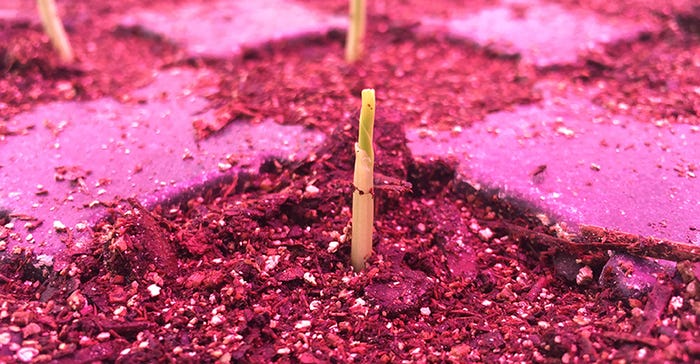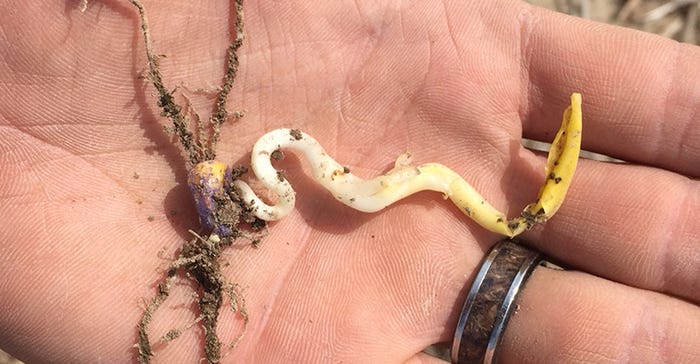April 1, 2019

Sponsored Content
This is the time of year that everybody gets antsy. Multi-year data from Beck’s Practical Farm Research (PFR)® shows that in corn and soybeans, early planting has the highest yield potential in many years. But there is a big caveat: early planting into fit, warm soils. Fit soils aren’t so wet that they will crust or compact. Warm soils are at least 50°F. If you get impatient, you risk setting back the crop before it is even out of the ground.
The first step in initiating seed germination is imbibition of water. As the seed takes on water (up to 30 percent of its own weight for corn and 50 percent for soybeans!), enzymes within the seed start converting starch from storage forms into forms that will help feed the newly awakened embryo. Cell membranes in the seed need to rehydrate to re-initiate growth; that process can go awry in cold temperatures.
POST-PLANTING PLANT PROCESSES:
Imbibition: Seed takes up water over a 48-hour period
Taking in cold water (<50°F) damages cell membranes and deforms seedlings
Elongation: The hypocotyl and radicle emerge and elongate
Cold temperatures slow down this process, leaving seedlings vulnerable to abiotic stress and seedling diseases
Germination
Corn: The coleoptile emerges from the soil surface. Cold temperatures slow the plant down, but the growing point is protected below ground until the V5 to V6 growth stage
Soybeans: The hypocotyl arch pushes up through the soil, taking the growing point with it. The growing point is exposed to frost after emergence (VE)


MONITOR SOIL TEMPERATURES: USE A MEAT THERMOMETER
Check soil temperature at planting depth (typically 1.5 to 2 inches).
Check the temperature early in the morning before the soil warms up. Soil temperatures regularly swing 10 to 20 degrees throughout the day.
Many state extension services or weather services offer soil temperature monitors that are accessible online.
Cool temperatures after the initial imbibition period may slow the plant down and delay emergence, but won’t be as dangerous as chilling in the first 48 hours. The emerging plant is vulnerable to fungi and disease, so using a comprehensive seed treatment like Escalate® powered by Nemasect™ can help to protect seedlings.

DECISION MAKING:
In a wet spring, you may be tempted to plant sandier soils first because they are the first to dry out. This can be problematic if there is a cold snap after planting because the sandy soil has less “insulating” effect and the seeds will be exposed to colder temperatures than those planted in heaver soils at the same time.
As you look at the forecast, think about it this way: will the plant have a “cold drink” or a “warm drink” immediately after planting? If it is a “cold drink,” consider delaying planting.
Soil variability affects soil temperature — be confident about the soil temperature of the coldest part of the farm before planting.

Beck’s Practical Farm Research (PFR)® has shown that early planting pays over time, but in specific years there can be a risk of being too aggressive getting into the fields. If soil temperature conditions are borderline and the forecast calls for a cool spell, you’re better off waiting to plant. If the forecasts show that the weather will be warmer, you may see a benefit from early planting. Typically, there is more to lose with late planting than early planting.
Soil temperature will either speed up or slow down establishment of your 2019 crop. The faster that crop comes out of the ground and starts making roots and leaves, the better. Waiting a few days for soils to warm up, or letting that last cold snap pass before you put your seed in the ground may make a big difference on yield in the fall. Remember that soils vary- you may have a few fields that are ready a week earlier than others are. It is a good idea to make a planting plan so that you can take advantage of early planting while managing the risk of planting into cold soil.
Escalate®, Nemasect™ and Practical Farm Research (PFR)® are trademarks of Beck’s Superior Hybrids, Inc. Beck’s PFR (https://www.beckshybrids.com/PFR/About-PFR) is the largest source of unbiased, cutting-edge agronomic information in the industry. More than 500 studies were conducted in 2017, comparing over 150 products across multiple locations to learn how different management practices and new technologies perform in field environments. In evaluating agronomic practices and input products, not comparing seed products, Beck’s PFR aims to help farmers maximize their input dollars and increase their bottom line. To view more PFR studies click here. (https://www.beckshybrids.com/pfresearch/)
About the Author(s)
You May Also Like




